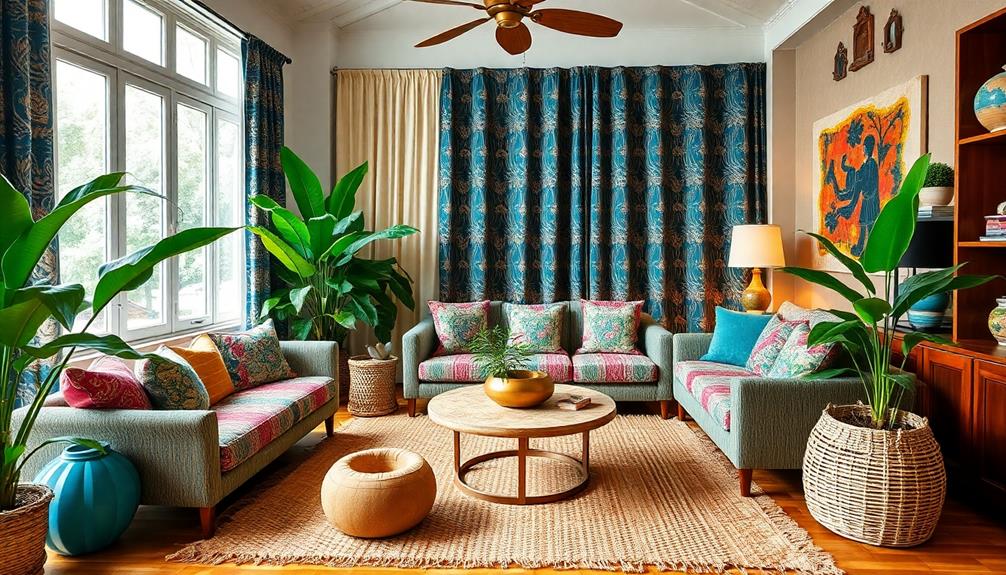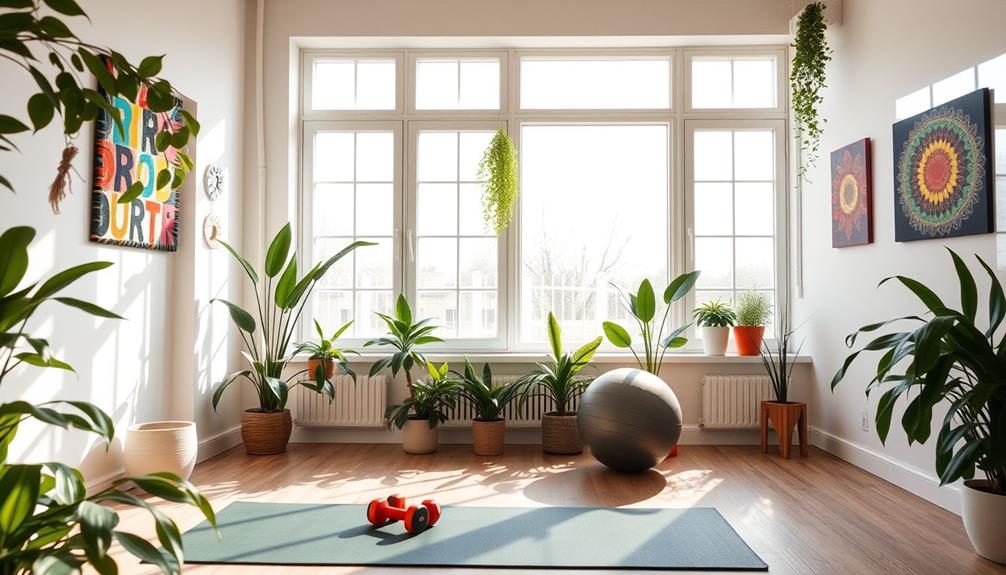To excel in integrating Indonesian textiles into your interior design, begin with a neutral base to showcase the vibrant patterns. Utilize batik as the main design element, complementing it with smaller ikat details for a striking contrast. Adhere to the 60:30:10 color ratio for a harmonious aesthetic. Add depth by incorporating various textures and opt for pieces dyed with natural colors for an authentic touch. Don’t forget to mix different scales; larger patterns can be focal points while smaller ones provide a subtle touch. Keep your choices limited to two or three key designs for a cohesive and unified appearance. Exploring additional techniques will further enhance the sophistication of your space.
Key Takeaways
- Start with a neutral base to allow vibrant Indonesian textiles like batik and ikat to stand out in your interior design.
- Use the 60:30:10 color rule to create balance, distributing colors effectively across patterns.
- Combine complementary patterns by selecting a shared color palette, ensuring visual cohesion between batik and ikat designs.
- Mix large and small patterns strategically to maintain harmony, using dominant batik designs as focal points.
- Incorporate textures and layers, such as hand-woven rugs and batik cushions, to add depth and richness to your space.
Understanding Indonesian Textiles

When you explore Indonesian textiles, you'll discover a vibrant world of batik and ikat, each boasting intricate patterns and rich cultural significance.
Batik, recognized by UNESCO, is created by applying wax to fabric before dyeing, resulting in detailed designs inspired by local flora and fauna. On the other hand, ikat employs a unique dyeing technique where threads are dyed before weaving, creating distinctive, blurred patterns that stand out.
Additionally, incorporating elements such as Indonesian decor masks can enhance the overall aesthetic of your space, offering a striking contrast to the textiles.
As you investigate deeper, you'll find that different regions in Indonesia, like Bali, Sumba, and Java, each have their own weaving and dyeing methods, contributing to the diverse tapestry of textiles available.
These hand-woven fabrics often utilize natural dyes from local plants and minerals, emphasizing sustainability and cultural authenticity in their production.
Understanding the significance of these textiles is essential when mixing patterns. Each design carries meaning, often reflecting community identity and heritage.
When you mix batik and ikat in your space, consider the stories behind them. Be mindful of the colors and patterns, and how they interact.
With thoughtful combinations, you can create a harmonious blend that celebrates the beauty and tradition of Indonesian textiles in your interior design.
The Beauty of Batik
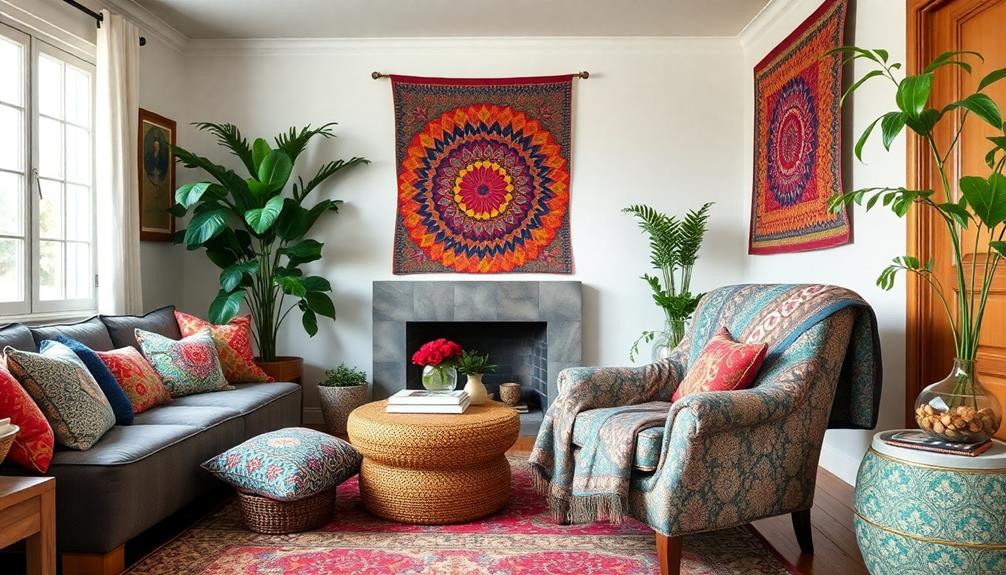
Batik is a stunning textile art that captivates with its intricate patterns and rich history. Originating from Indonesia, batik dates back to the 6th century and showcases an incredible array of designs, each telling a story.
As you explore batik, you'll find that its beauty lies not only in the artistry but also in the significance of its motifs. Additionally, batik can be beautifully paired with other Indonesian decorative pillows to create a cohesive and colorful aesthetic in your home.
Here are three reasons why batik deserves a special place in your interior design:
- Cultural Heritage: Batik is recognized by UNESCO as a Masterpiece of the Oral and Intangible Heritage of Humanity, connecting you to Indonesia's remarkable traditions.
- Unique Patterns: Each piece of batik tells a story through its intricate designs, reflecting local flora, fauna, and cultural themes, making it a unique addition to your home.
- Versatility: With various types of batik, like Batik Tulis, Batik Cap, and Batik Lukis, you can choose pieces that fit your personal style and enhance your decor.
Incorporating batik into your space not only elevates your home but also honors a rich artistic legacy.
Key Techniques for Mixing Patterns

Incorporating various Indonesian textiles like batik into your home opens up exciting opportunities for mixing patterns. To create a cohesive look, combine complementary patterns such as batik and ikat by selecting a shared color palette.
Start with a dominant batik pattern to anchor your design, and layer smaller patterns like ikat or floral prints as accents. This approach maintains visual interest without overwhelming your space and aligns beautifully with Balinese design characteristics that emphasize cultural elements and natural materials.
When you mix and match, consider the scale of the patterns. Pairing large batik designs with smaller ikat motifs offers contrast and harmony, contributing to a balanced aesthetic.
It's also wise to lay a foundation with solid colors before introducing patterns, ensuring that your mix remains grounded and visually appealing.
Lastly, trust your instincts. If an element feels out of place or clashes with your chosen textiles, it might be best to exclude it for a more harmonious interior.
Color Coordination Essentials
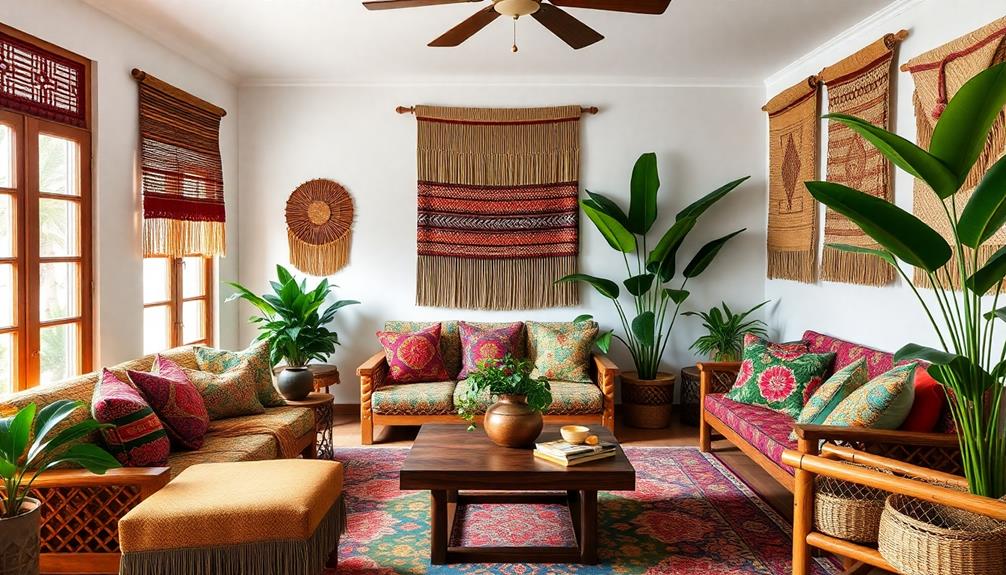
To create a harmonious space with Indonesian textiles, you'll want to focus on color coordination that enhances your overall design. Incorporating traditional elements, such as vibrant Indonesian decor masks, can further enrich the aesthetic of your living room.
One key method is the 60:30:10 rule, where 60% of your decor features a dominant color, 30% is a secondary hue, and 10% serves as an accent. This balance helps maintain visual harmony.
Here are three tips to guide you:
- Choose a Neutral Base: Ground your bold Indonesian patterns with neutral tones. This allows the intricate designs to shine without overwhelming the space.
- Utilize Color Families: Incorporate complementary color families, like blues and greens or oranges and yellows, to enhance cohesion among different textiles.
- Test Color Combinations: Use swatches of various Indonesian textiles to visualize their interactions. This step guarantees your aesthetic remains harmonious and tailored to your style.
Scale and Proportion in Design
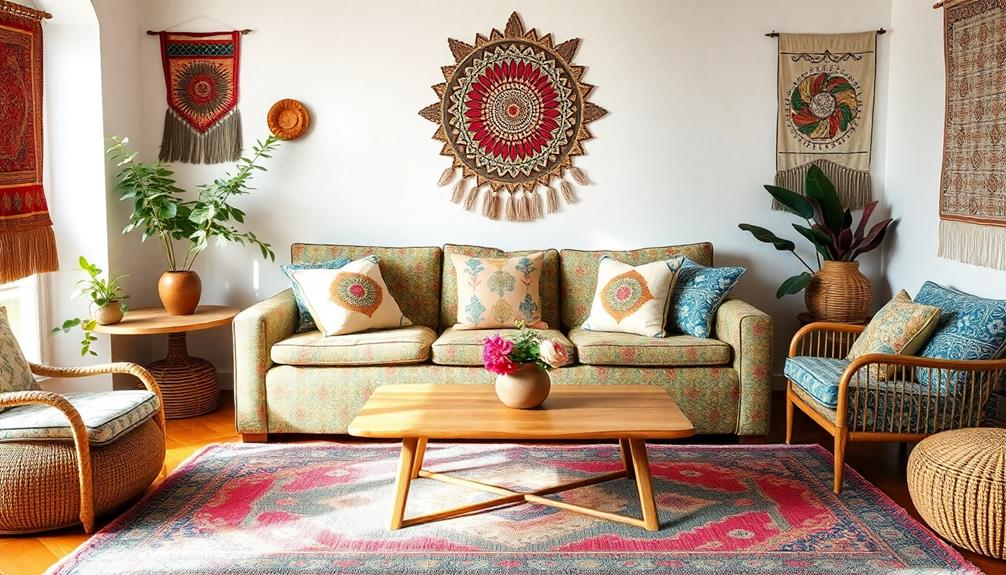
When mixing Indonesian textiles, understanding the scale of patterns is key to achieving visual harmony in your space.
Larger batik designs can act as bold focal points, while smaller woven pieces provide subtle accents that complement them.
Incorporating elements like Indonesian decor masks can further enhance your design by introducing cultural storytelling.
Understanding Pattern Scale
Balance is essential in design, especially when mixing patterns in your interior space. Understanding pattern scale can transform your room from chaotic to enchanting, much like the traditional Indonesian style home decor that emphasizes harmony and natural aesthetics.
Larger patterns often serve as bold focal points, while smaller ones provide essential accents, creating a visual contrast that enhances harmony. Here are three key tips to master pattern scale:
- Choose Your Dominant Pattern: Select a large Indonesian textile, like a batik, to anchor your design. This will help establish a strong foundation for your space.
- Accent with Smaller Patterns: Incorporate smaller patterns, such as ikat, to complement your dominant piece. This adds depth and keeps the space visually engaging without overwhelming it.
- Maintain Cohesion: Confirm that your mix of large and small patterns maintains a curated look. A well-proportioned combination allows the unique artistry of Indonesian textiles to shine without competing for attention.
Achieving Visual Harmony
Mixing Indonesian textiles isn't just about choosing the right patterns; it's also about achieving visual harmony through scale and proportion. When you're selecting textiles for your interior design, consider the scale of your patterns. Incorporating elements of traditional Indonesian housing can inspire unique combinations that reflect cultural significance.
Pairing large batik designs with smaller motifs creates visual interest without overwhelming the space. For instance, a striking batik wall hanging can be beautifully complemented by smaller cushion covers, establishing a focal point while maintaining balance.
Proportion plays an important role in ensuring that your textiles complement your furniture and decor. This cohesive aesthetic enhances the overall room, allowing each element to shine. Pay attention to the visual flow—arranging textiles thoughtfully guides the eye across the space, creating seamless shifts.
To avoid chaos in your design, limit the number of different patterns to two or three key designs in varying scales. This approach fosters a polished, intentional look that reflects your style while embracing the rich heritage of Indonesian textiles.
With these strategies, you'll master the art of mixing textiles and achieve a harmonious interior that feels both vibrant and cohesive.
Textures That Elevate Spaces

Incorporating Indonesian textiles into your interior design instantly elevates the texture and depth of your living spaces. By embracing the unique characteristics of these textiles, you can create a warm and inviting atmosphere that tells a story. Whether through handwoven ikat patterns, intricate batik designs, or luxurious silk, each piece reflects centuries of tradition and craftsmanship. Indonesian textiles in modern interiors offer a rich blend of cultural heritage and contemporary style, making them a versatile choice for any space. Their bold patterns and organic materials also provide a timeless aesthetic that balances both elegance and comfort. Incorporating Indonesian fabrics in interior design not only adds visual appeal but also infuses a sense of global connectivity and authenticity into your home. These fabrics can be used for anything from cushions and throws to upholstered furniture, seamlessly blending with modern décor while paying homage to the artisanal traditions behind them. By weaving together heritage and innovation, indonesian fabrics in interior design invite both luxury and storytelling into your personal space.
Adding elements like traditional batik patterns can further enhance your design, making it reflect cultural heritage and vibrant color palettes that embody Indonesian culture. Here are three key ways to enhance your space:
- Layering Textiles: Combine soft cottons with heavier materials to achieve visual weight and a cozy feel in any room. This contrast adds richness and invites comfort.
- Natural Dyes: Choose textiles dyed with natural colors sourced from local plants. These organic textures not only connect you to nature but also celebrate traditional craftsmanship, enhancing the authenticity of your decor.
- Versatile Designs: Experiment with reversible textiles from regions like Sumba. This versatility allows you to refresh your interior seasonally and shift the mood of your space effortlessly.
Mixing traditional Indonesian textiles with contemporary designs creates a dynamic aesthetic that highlights the beauty and cultural significance of these pieces.
Practical Tips for Implementation
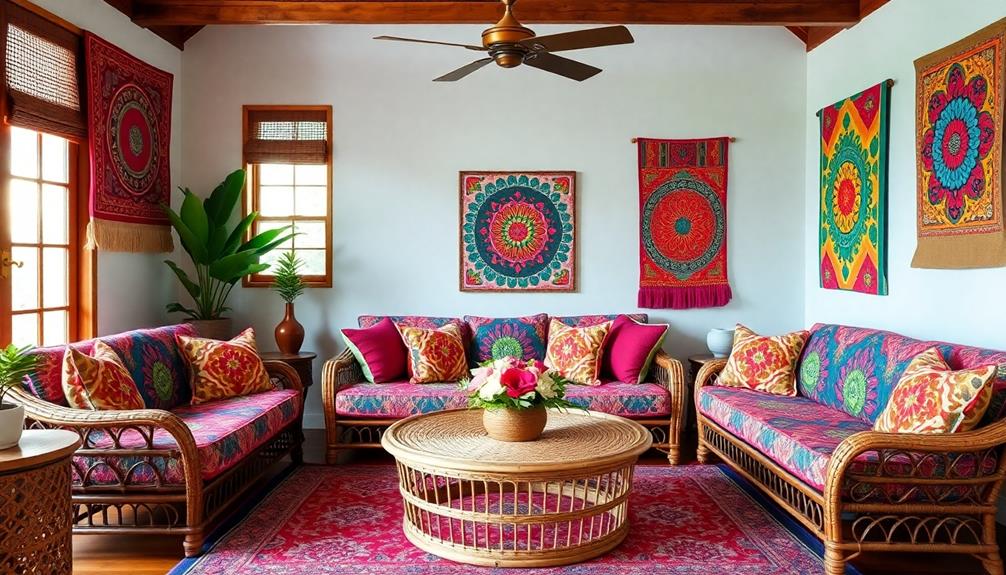
To make the most of Indonesian textiles in your home, start with a neutral base that allows the vibrant colors and intricate patterns to shine. This foundation guarantees that your Indonesian textiles can take center stage without overwhelming the space.
Incorporate a mix of hand-woven textiles from different regions, like ikat from Bali and batik from Java, to enrich your décor with cultural heritage and design variety. Consider visiting local shops for unique pieces that reflect sustainable craftsmanship in Balinese furniture to further enhance your interior design.
Use the 60:30:10 color rule for effective pattern distribution: let Indonesian textiles dominate at 60%, supported by 30% secondary patterns and 10% accent colors. This balance creates a visually appealing arrangement.
Layering textiles adds depth; think about combining a hand-woven rug with batik cushions for a tactile richness.
Don't forget to refresh your space! Rotate your Indonesian textiles seasonally or as your decor changes to keep things interesting. This practice highlights the unique craftsmanship and artistry of Indonesian weavers throughout the year, guaranteeing your home remains vibrant and inviting.
Personalizing Your Textile Choices

When personalizing your textile choices, it's essential to select pieces that resonate with your unique style and preferences. Hand-woven fabrics from regions like Sumba and Bali can add a vibrant touch to your space, showcasing intricate ikat patterns that reflect local culture.
Additionally, incorporating elements of modern tropical aesthetics with natural materials can enhance the overall harmony of your interior.
Here are three ways to make your selections truly yours:
- Choose reversible textiles: They offer versatility and let you easily switch up the mood of a room, adapting to your changing tastes.
- Mix and match pillows: Incorporating various regional designs creates a unique aesthetic and highlights the artisans' craftsmanship. This personal touch can evoke a sense of connection to the rich heritage behind each piece.
- Opt for textiles with natural dyes and traditional motifs: These not only enhance beauty but also tell stories of the local artisans, enriching your space with cultural significance.
Frequently Asked Questions
How to Mix Patterns in Interior Design?
To mix patterns in interior design, start with a dominant pattern as your anchor. Balance it with subtler ones, ensuring a cohesive color palette and varying the scale for depth and contrast throughout your space.
How Do You Mix Textiles?
Mixing textiles is like weaving a tapestry; you'll create a beautiful story. Focus on balancing colors and patterns, layering textures, and embracing cultural significance. Don't shy away from experimenting—your unique style will shine through!
How Are Textiles Used in Interior Design?
Textiles in interior design add style and comfort. You can use them as decorative accents like pillows or functional items like rugs. They bring color and texture, transforming spaces while reflecting your personal taste and creativity.
Conclusion
Incorporating Indonesian textiles into your interior can be a delightful design adventure. By blending bold batik with beautiful patterns and coordinating colors, you create an inviting atmosphere filled with character. Remember to reflect on scale and texture to truly transform your space. So, don't hesitate—dare to plunge into this dynamic decor journey! Embrace the elegance of Indonesian artistry and personalize your home with pieces that speak to your style. Happy mixing!
